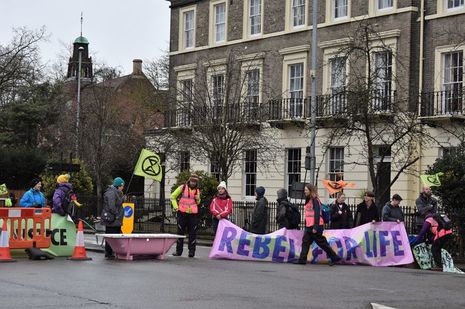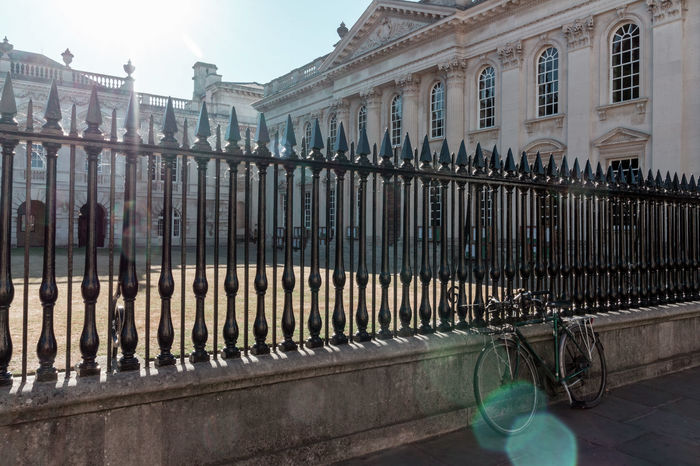The radicalism of Extinction Rebellion remains at odds with its exclusion of BME activists
Mary-Hannah Oteju argues that Extinction Rebellion should be more inclusionary for BME activists, and have a larger focus on climate change in the Global South

“Climate Justice is social justice.” These are words in bold print, plastered on the front of the flyer that Extinction Rebellion (XR) have been distributing all over the city. The activists of this movement cannot be faulted for their urgency concerning the state of the Earth’s ecology. Neither should their protesting, whether on the front lawns of Trinity college or in the middle of Trumpington Street, be disregarded as ‘unnecessary’ or ‘too radical’. The state of our climate necessitates this immediacy. However, what must be addressed is the widespread lack of representation that riddles this organisation. In an attempt to advocate for social justice, XR fails to confront the exclusivity in regard to people of colour within its activist framework.
According to Time Magazine, the top six cities and countries to be most severely affected by climate change are Lagos (Nigeria), Haiti, Yemen, Manila and the United Arab Emirates. The statistics from GermanWatch Climate Risk Index also suggest similar climate change trajectories, naming the top ten countries most affected by climate change in 2019 as Puerto Rico, Sri Lanka, Dominica, Nepal, Peru, Vietnam, Madagascar, Sierra Leone, Bangladesh and Thailand. Countries in the Global South are, and will continue to be, most affected by climate change, despite not being the primary contributors to these widespread ecological issues.
“There is nothing rebellious about a movement that focuses on the work in the Western world while neglecting the fundamental needs of the Global South.”
Whilst it is indeed the responsibility of the Global North – and particularly the West – to begin to rectify the climate issues that it has caused, it is no less important to work alongside these “marginalised communities both in the UK and around the world” (as quoted in XR’s own flyer) to truly bring about climate justice.
XR activists applaud the movement’s rapid growth, having mobilised centres in over 57 countries in less than 18 months. However, only one of these centres is in one of the countries, listed above (Peru), most affected by the climate catastrophe. Evidently, in their urgency to address climate change, XR fails to apply this same exigency in representing those who are most affected by this climate change.
A quick Google image search, a browse through the XR website, a wander through the city, or even a glance at Trumpington Street during protests makes it clear that XR is lacking BME representation. To avoid becoming yet another Western saviour movement, it is imperative that XR begins to partner with the individuals and organisations that already work to protect and strengthen these ecologically and often socio-politically vulnerable regions. There is nothing rebellious about a movement that focuses on the work in the Western world while neglecting the fundamental needs of the Global South.
For myself, as well as many other students of colour – particularly those with closer relations to the regions mentioned above – it is difficult to take movements such as XR seriously when they offer a very limited view of climate change. How far can one align themselves with a movement that does not represent in image or outreach the communities most vulnerable to climate change? Moreover, pertaining to the protests and disruptions caused by XR, it is necessary to comment on the nature of these events and how it once again neglects to address the real-world impact that said protests cause. It goes without saying that people of colour, particularly Black people, are disproportionately targeted by the police, and are 40 times more likely to be stopped and searched in the UK.
“For students of colour within Cambridge, particularly Black students, public protesting is a dangerous territory to venture into.”
For students of colour within Cambridge, particularly Black students, public protesting is a dangerous territory to venture into. A few days following the XR protest in front of Trinity, one graduate student wrote about his experience of racial profiling at St Catherine’s College. He was physically assaulted by a college porter, who then went on to deny his actions. Collin Edouard, the master’s student from Wolfson College affected by this incident has since received an apology from the Master of the College. However, this is not the first time events like these have been recorded and shared. Neither can an apology begin to resolve the explicit biases faced by Black students at Cambridge.
If Black students are at such risk of confrontation by simply entering Cambridge colleges until their white counterparts intervene, what then could ensue when protesting on Colleges’ lawns and property? What then would XR do to reconcile their urgency to “bring the city to a halt” ( as quoted in an XR flyer) in such public ways with the blatant risks that disproportionately would affect students of colour?
Principle 6 of XR is “We welcome everyone and every part of everyone. Working actively to create safer and more accessible spaces.” The reality, however, is that with the direct action at the centre of the movement, not everyone can afford to put their liberty and safety at risk. Within XR, it is unclear what measures have been put in place to protect and represent people of colour. It is unclear what roles PoC members and allies can take which effectuate non-performative change in a way that does not put them at risk. These concerns, coupled with the fact that the movement does not seem to squarely address the regions to be most affected by climate change, further elucidates the exclusionary nature of XR.
“Rebel for Justice.” Despite the high-spirited sentiment behind this phrase, in practice, this ‘rebellion’ is heavily polemicized. Justice cannot only mean holding the Cambridge Council or the UK government responsible for their lack of action as it pertains to the ongoing climate emergency. Justice must mean working directly for and alongside the communities and regions most impacted by climate change.
Justice must mean considering the implications for students of colour who wish to align themselves with XR, and creating spaces for them to function within these spaces. Justice must mean inclusion. Unfortunately, XR, contrary to what its anarchistic mantra states, is more than compliant in this area.
 Features / Should I stay or should I go? Cambridge students and alumni reflect on how their memories stay with them15 December 2025
Features / Should I stay or should I go? Cambridge students and alumni reflect on how their memories stay with them15 December 2025 News / Cambridge study finds students learn better with notes than AI13 December 2025
News / Cambridge study finds students learn better with notes than AI13 December 2025 News / Uni Scout and Guide Club affirms trans inclusion 12 December 2025
News / Uni Scout and Guide Club affirms trans inclusion 12 December 2025 Comment / The magic of an eight-week term15 December 2025
Comment / The magic of an eight-week term15 December 2025 News / Cambridge Vet School gets lifeline year to stay accredited28 November 2025
News / Cambridge Vet School gets lifeline year to stay accredited28 November 2025









